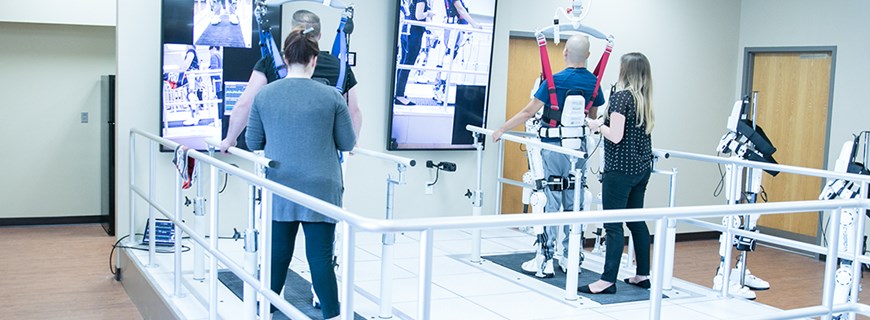Revolutionary Robotic Treatment For Patients With Spinal Cord Injuries Now Available In United States

Back to physical health resource hub
Revolutionary Robotic Treatment For Patients With Spinal Cord Injuries Now Available In United States
New advanced technology available at Brooks Rehabilitation, in partnership with Japan-based
Cyberdyne, Inc.
Jacksonville, FL (March 2, 2018): Brooks Rehabilitation, an industry leader in post-acute physical rehabilitation, announced today its partnership with Japanese medical and social innovation company, CYBERDYNE, INC., to introduce and make available the world’s first advanced robotic treatment device that has been shown to improve a patient’s ability to walk. Individuals with spinal cord injuries can now access FDA-cleared HAL, which is short for Hybrid Assistive Limb, at the Brooks Cybernic* Treatment Center in Jacksonville, FL. The Treatment Center is currently the only facility in the U.S. offering this innovative treatment.
“We’ve already seen the results of improved mobility and ability to walk in patients with spinal cord injury (SCI) at several international locations that are providing this technology,” said Dr. Geneva Tonuzi, Medical Director of the Brooks Cybernic Treatment Center. “We are thrilled to finally have this unique technology available here at Brooks Rehabilitation as it opens the door to more research and treatment methods in advancing spinal cord injury treatment.”
Recently implemented in Japan, Germany and other countries, HAL fits to the patient’s lower limbs and trunk, and operates using internal signals from the body. This powered lower extremity exoskeleton is unique from any other exoskeleton treatment available today because the device’s movements are neurologically-controlled by the patient’s volition, and use of its secondary Biofeedback Device features allows the patient to see and adjust the signals they are producing. This functional integration of human neural pathways with modern technology is a landmark advancement for SCI patients nationwide.
How It Works:
- Sensors attach to the patient’s lower extremities.
- When the patient intends to move, muscles receive nerve signals from the brain, and faint bio-electrical signals are detected on the skin’s surface.
- HAL uses sensors to detect these signals and assists with desired movements, while also enhancing strength and stability.
- Active use of neural pathways for voluntary movement with physical feedback to the brain leads to improved ability for the patient to walk on their own.
The vision and innovation for Cyberdyne, Inc. and HAL is that of Dr. Yoshiyuki Sankai, President and CEO of Cyberdyne, Inc. and Professor at the University of Tsukuba, Japan.
“Wearing HAL leads to a fusion of human, robot, and information systems,” said Dr. Sankai. “I’m pleased that Cybernic Technology will now benefit patients in the U.S., helping to improve their walking ability as well as gain other functional and physiological benefits.”
Patients who participate in HAL treatments at the Brooks Cybernic Treatment Center can also choose to share their treatment data for clinical research trials that further evaluate the benefits of HAL interventions and future improvement opportunities.
For more information on HAL, it’s use and the partnership, please visit www.brookscyberdyne.org.
About Brooks Rehabilitation
Brooks Rehabilitation has been serving the southeast for more than 50 years. As a nonprofit organization based in Jacksonville, FL, Brooks operates one of the nation’s largest inpatient rehabilitation hospitals in the U.S. with 160 beds, one of the region’s largest home healthcare agencies, 32 outpatient rehabilitation clinics, a skilled nursing unit dedicated to orthopedic rehabilitation, the Brooks Rehabilitation Medical Group, two skilled nursing facilities, assisted living and memory care. In addition, Brooks operates the Clinical Research Center, which specializes in research for stroke, brain injury, spinal cord injury and more to advance the science of rehabilitation. Brooks also provides many low or no cost community programs and services such as the Brooks Clubhouse, Brooks Aphasia Center and Brooks Adaptive Sports and Recreation to improve the quality of life for people living with physical disabilities. Brooks will see more than 45,000 patients throughout our system of care in 2018. For more information, visit BrooksRehab.org.
About Cyberdyne, Inc.
Since its establishment as a venture company from the University of Tsukuba in 2004, Cyberdyne, Inc. has promoted the comprehensive development of various Cybernic* Systems (Cybernic devices, Cybernic interfaces, etc.) that utilize Cybernic Technology from research and development to social implementation, aiming to tackle the various issues facing society. The Company has developed business in the fields of medicine, welfare and daily living (including the work environment), and its main product Robot Suit HAL® is widely distributed not only in the medical and welfare fields but also in care support and labor support fields. In addition, new products such as Transport Robots and Cleaning Robots equipped with artificial intelligence and environment recognition functions, HAL Lumbar Type that reduces the load and stress on the lower back, smaller-sized HAL (Single-Joint Type), Vital Sensors for detecting arteriosclerosis and arrhythmia measurements, etc. are continuously being developed. For more details, please refer to the following website: www.cyberdyne.jp/eng/
* “Cybernics” (adjective: Cybernic) is a new academic field that is centered around cybernetics, mechatronics and informatics fused/combined with various other fields including brain/neuroscience, robotics, biology, behavioral science, psychology, law, ethics, and business administration. Cybernics is championed by Yoshiyuki Sankai, a professor at the University of Tsukuba in Japan.
###


